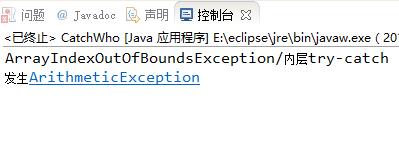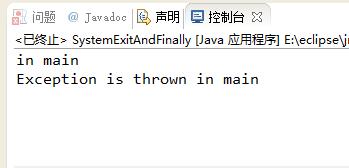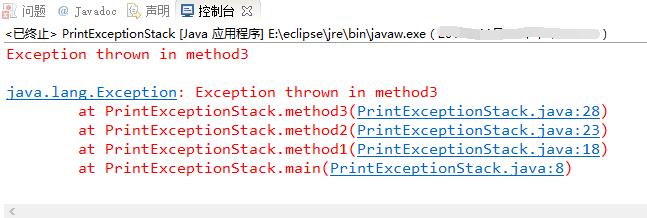1.请阅读并运行AboutException.java示例,然后通过后面的几页PPT了解Java中实现异常处理的基础知识。
import javax.swing.*; class AboutException { public static void main(String[] a) { int i=1, j=0, k; k=i/j; try { k = i/j; // Causes division-by-zero exception //throw new Exception("Hello.Exception!"); } catch ( ArithmeticException e) { System.out.println("被0除. "+ e.getMessage()); } catch (Exception e) { if (e instanceof ArithmeticException) System.out.println("被0除"); else { System.out.println(e.getMessage()); } } finally { JOptionPane.showConfirmDialog(null,"OK"); } } }

把可能会发生错误的代码放进try语句块中。 当程序检测到出现了一个错误时会抛出一个异常对象。异常处理代码会捕获并处理这个错误。 catch语句块中的代码用于处理错误。 当异常发生时,程序控制流程由try语句块跳转到catch语句块。 不管是否有异常发生,finally语句块中的语句始终保证被执行。
2.阅读以下代码(CatchWho.java),写出程序运行结果:
public class CatchWho { public static void main(String[] args) { try { try { throw new ArrayIndexOutOfBoundsException(); } catch(ArrayIndexOutOfBoundsException e) { System.out.println( "ArrayIndexOutOfBoundsException" + "/内层try-catch"); } throw new ArithmeticException(); } catch(ArithmeticException e) { System.out.println("发生ArithmeticException"); } catch(ArrayIndexOutOfBoundsException e) { System.out.println( "ArrayIndexOutOfBoundsException" + "/外层try-catch"); } } }

写出CatchWho2.java程序运行的结果:
public class CatchWho2 { public static void main(String[] args) { try { try { throw new ArrayIndexOutOfBoundsException(); } catch(ArithmeticException e) { System.out.println( "ArrayIndexOutOfBoundsException" + "/内层try-catch"); } throw new ArithmeticException(); } catch(ArithmeticException e) { System.out.println("发生ArithmeticException"); } catch(ArrayIndexOutOfBoundsException e) { System.out.println( "ArrayIndexOutOfBoundsException" + "/外层try-catch"); } } }

当有多层嵌套的finally时,异常在不同的层次抛出 ,在不同的位置抛出,可能会导致不同的finally语句块执行顺序。
3.辨析:finally语句块一定会执行吗?
public class SystemExitAndFinally { public static void main(String[] args) { try{ System.out.println("in main"); throw new Exception("Exception is thrown in main"); //System.exit(0); } catch(Exception e) { System.out.println(e.getMessage()); System.exit(0); } finally { System.out.println("in finally"); } } }

因此finally语句不一定执行
4.如何跟踪异常的传播路径?
// UsingExceptions.java // Demonstrating the getMessage and printStackTrace // methods inherited into all exception classes. public class PrintExceptionStack { public static void main( String args[] ) { try { method1(); } catch ( Exception e ) { System.err.println( e.getMessage() + " " ); e.printStackTrace(); } } public static void method1() throws Exception { method2(); } public static void method2() throws Exception { method3(); } public static void method3() throws Exception { throw new Exception( "Exception thrown in method3" ); } }

当程序中出现异常时,JVM会依据方法调用顺序依次查找有关的错误处理程序。
每个Throwable类的对象都有一个getMessage方法,它返回一个字串,这个字串是在Exception构造函数中传入的,通常让这一字串包含特定异常的相关信息。
5.成绩:
import java.util.Scanner; class judgeException extends Exception{ public judgeException(String s){ super(s); } } class judgeException2 extends Exception{ public judgeException2(String s){ super(s); } } public class Test { public static void main(String[] args) { boolean p=true; while(p){ System.out.println("请输入学生的分数:"); Scanner in=new Scanner(System.in); String s=in.next(); try{ for(int i=0;i<s.length();i++){ if((s.charAt(i)<48||s.charAt(i)>57)){ throw new judgeException("输入错误,请输入一个数字:"); } } try{ int m=Integer.parseInt(s); if(m<0||m>100){ throw new judgeException2("请输入正确的分数"); } if(m<60){ System.out.println("不及格"); } else if(m>=60&&m<=69){ System.out.println("及格"); } else if(m>=70&&m<=79){ System.out.println("中"); } else if(m>=80&&m<=89){ System.out.println("良"); } else if (m>=90&&m<=100){ System.out.println("优"); } } catch(judgeException2 e){ System.out.println(e.getMessage()); } } catch (judgeException e){ System.out.println(e.getMessage()); } } } }
